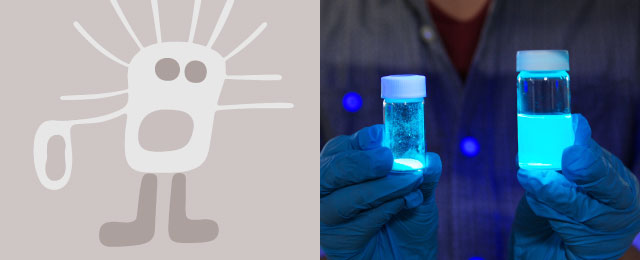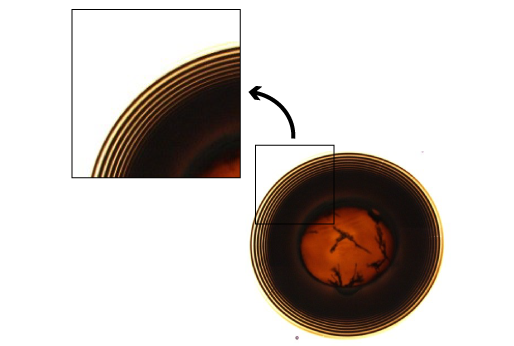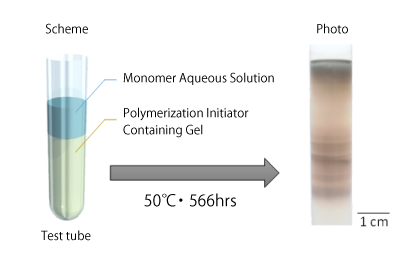







Home > Research > Research Highlights > Chemistry > Discovery of New Chemical Models which Reveal the Mysteries of Patterns in Nature
date: 2018.03.01
The Liesegang phenomenon is a phenomenon that forms various periodic structures such as striped patterns or concentric rings. It was discovered in 1896 by using a chemical substance which is difficult to dissolve in water (hardly soluble salt). Since chemically formed Liesegang pattern resembles periodic structures spontaneously created in nature such as agate patterns and the array of planets in the solar system, various models have been proposed for the chemical Liesegang pattern formation for clarifying the structure of forming periodic structures in nature. However, there have been two restrictions on these proposed models: 1) observation is only possible in hardly soluble substances, and 2) observation is only possible in reactions accompanying crystal precipitation from molecules.
In 2014, a research group led by Professor Nabika found that Liesegang pattern could be formed by a reaction between a reducing agent and a metal ion in a thin gelatin film. The group discovered that the metal nanoparticles which are the reaction product are integrated spontaneously into a concentric rings (pic.1). In other words, the research group succeeded in observing the Liesegang phenomenon in a chemical reaction product other than a hardly soluble salt. As a result, the group proved that restriction 1) listed above no longer required.
Further research was conducted. In 2017, during research of a polymerization reaction using gel and monomer aqueous solution, it was discovered that the reaction product precipitates concentrically (pic.2). This reaction was structured in a chemical reaction product other than a hardly soluble salt and does not accompany crystal deposition. Accordingly, it marked the discovery of a chemical reaction that generates the Liesegang phenomenon without fulfilling either of the two requirements listed above. These results are the most comprehensive and highest-ranking model for explaining the chemical reaction Liesegang phenomenon that was proposed in 1896. This comprehensive model can be expanded to a variety of reaction systems.
This has greatly advanced the unified understanding for various Liesegang structures in nature. From the origin of the solar system to disease prevention, clarification of the history of the Earth, and urban planning, this discovery is expected to surpass the boundaries of chemistry and contribute to the growth of space structure sciences which encompass the natural sciences and social sciences.
Professor NABIKA Nabika, Ph.D. (Chemistry)

▲pic.1
The thin gelatin film in which the Liesegang rings of metal nanoparticles appeared. The part of the orange ring is an area where metal nanoparticles are deposited.
Quoted from H. Nabika et al., Langmuir (DOI: 10.1021/la5003786)

▲pic.2
Scheme of Experiment
Related Links